Homeopathic remedies contain clusters in ultra high diluted solutions above Avogadro number – this is the long awaited proof that homeopathic remedias are not placebo but active remedies!
(The term Avogadro limit expresses the fact that, above a certain dilution, mathematically no particles of the original substance are left.)
Ultra-high dilutions analysis: Exploring the effects of potentization by electron microscopy, Raman spectroscopy and deep learning
For the past eight years, the dedicated Research Team of the International Academy of Classical Homeopathy, under the guidance of Professor George Vithoulkas and the thorough work of the Head of the Team, Dr Camelia Grosan, has been diligently working to provide conclusive evidence refuting the long-standing skepticism surrounding homeopathic remedies.
Through a meticulous combination of advanced analytical techniques including Transmission Electron Microscopy (TEM), Raman Spectroscopy, and Deep Learning (DL) algorithms, this study successfully confirms that homeopathic remedies are active. The investigation focused on evaluating the morphological characteristics of highly diluted solutions of gold (Aurum Met) prepared in both ethanol and water bases across three different levels of potentization (6C, 30C, and 200C). The findings presented in this research definitively settle the debate on the high potencies in homeopathy.
The analytical method employed in this study, we believe, will open new vistas in medicine.
You will find the paper here:
https://www.sciencedirect.com/science/article/pii/S0167732224005932?via%3Dihub
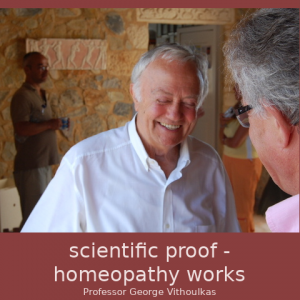 |
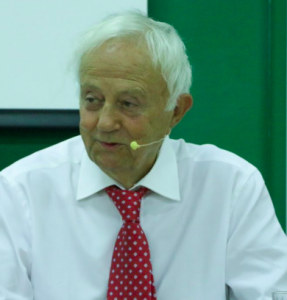 |
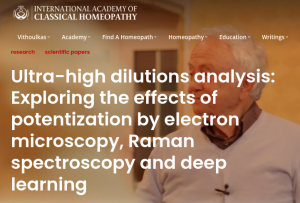
The subject of ultrahigh dilutions has been under continuous debate over the years, mainly because the possi
bilities to analyze such diluted solutions are limited. In this context, transmission electron microscopy (TEM)
investigations were conducted to evaluate the morphological characteristics of ethanol- and water-based highly
diluted solutions of gold; three levels of potentization (6C, 30C, and 200C) were examined for each type of
solution. Moreover, Raman spectroscopy and deep learning (DL) algorithms were employed for the analysis of
the three potentization levels of purified water, unpurified water, and purified water-based gold solutions. Three
batches were assessed for each considered category, and the ability to discriminate between all investigated
classes, between the potencies within each group or between the classes within the same level of potentization
were presented and discussed in correlation with the TEM findings. Distinct forms of organization were revealed
by TEM for the three levels of potentization, while the gated recurrent unit (GRU) model showed great accuracy
(88 %) for discriminating all classes, over 90 % accuracy for distinguishing the samples within each group and
over 95 % accuracy for classification within the same level of potentization if unpretreated Raman spectra were
used. Thus, this suite of methods (TEM-EDX and Raman spectroscopy in combination with DL) can be suc
cessfully used for the characterization and differentiation of highly diluted solutions resulting after potentization
treatment. Furthermore, considering the results obtained from the discrimination study involving all 11 classes
and a data augmentation approach, the spectral segmentation method can be seen as a valuable strategy for
increasing the model prediction accuracy.
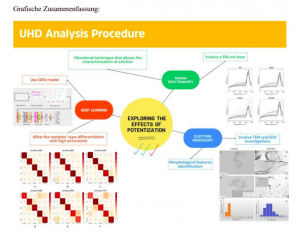
All these observations suggest a different organization for the 6C and
30C potencies of AUR and indicate the presence of both nanoparticles
and cluster assemblies in the 30C samples. Thus, the clear nanoparticle
shape of impurities and the filiform/cluster assemblies formed from
small structures promote the idea that at least for AUR 30C, the observed
organization is not primarily related to the nanoparticulate systems, but
more to large assemblies (clusters) of small structures. Most likely, these
clusters also contain ethanol and water (in E-AUR) or water (in W-AUR)
molecules, while impurities, either isolated or linked to these large as
semblies, appear as nanoparticles (clear round shape and different
sizes). Although gold was identified in all the investigated samples, it
appears scattered on the grid surface in the TEM-EDX mapping images.
The results obtained for the AUR 200C samples suggest an extended
organization of AUR 200C molecules, indicating the existence of stable
and organized structures over a larger area. The impurities are present as
large assemblies (Fig. S10B); thus, large impurities (micrometer scale),
such Si, Al, Fe and O, linked together can be seen in the TEM-EDX
mapping results. The filiform profile can be also noted for the W-AUR
200C samples (Fig. 3A,3D) as well as the occurrence of some carbon (C)-
based structures in E-AUR 200C (Figs. S10A and S10C), and the presence
of gold in the two types of investigated 200C samples (Fig. 3 inset and
Figs. S9 and S11B).
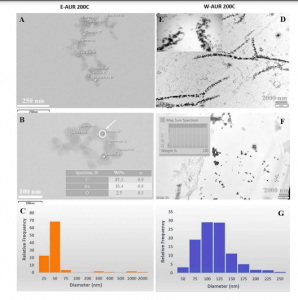 Some of these results are supported by the literature; for example, the
Some of these results are supported by the literature; for example, the
presence of gold, even at high potencies (30C and 200C) of AUR that are
beyond the Avogadro number, was also shown in the papers of Chik
ramane et al. [10] and Rajendran [47]. In the work of Chikramane et al.,
the elemental composition of TEM particles was identified by selected
area electron diffraction (SAED) and confirmed by ICP–AES analysis
[10]. The study of Rajendran highlights the idea that nanoparticles are
found mostly on the quantum dot scale in all solutions [47]; their par
ticle sizes are approximately similar to our data. This nanoparticulate
perspective is also supported by our findings, but in addition, our results
demonstrate that AUR’s structure combines nanoparticles and cluster
arrangements composed of smaller or larger nanostructures. These
cluster arrangements are more evident for the high dilutions that are
beyond the Avogadro number and are influenced by the solvent nature
and by the level of potentization; the higher the potency is, the more
branched and larger the formed structures are. Extension of this orga
nization over a large area should lead to structures that are more stable
and could be in accord with the constructal law of design and evolution
in nature, as described by Bejan and Lorente [46].
Conclusion
Overall, by analyzing the results obtained from TEM-EDX and the
methodology based on Raman spectroscopy and DL algorithms, we can
argue that these methods can be successfully used for the character
ization of ultrahigh dilutions. This suite of techniques revealed a
modality that could be the basis for discriminating different remedies in
accordance with the nature of the initial substances used to prepare the
remedies or could allow the differentiation of samples based on their
level of potentization. This approach allows the analysis of the highly
diluted solutions on a far larger scale than was achievable in the past.
–-> IACH international Academy of classical homeopathy in Alonnisos, Greece
To be successful with homeopathic treatment, you need a highly trained homeopath:
–> Homeopaths trained in the International Academy IACH
